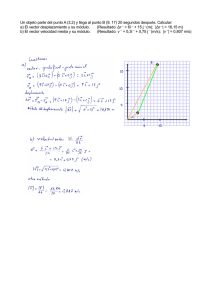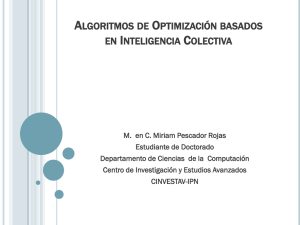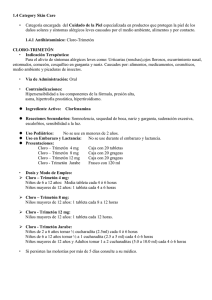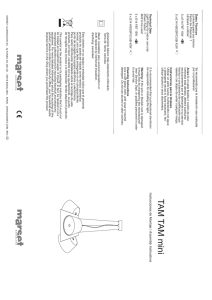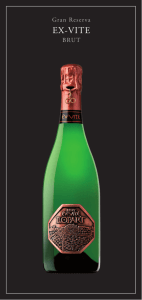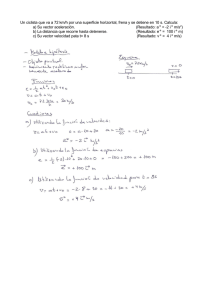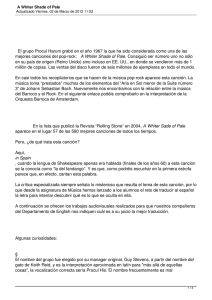Shade y L-Shade - Soft Computing and Intelligent Information Systems
Anuncio
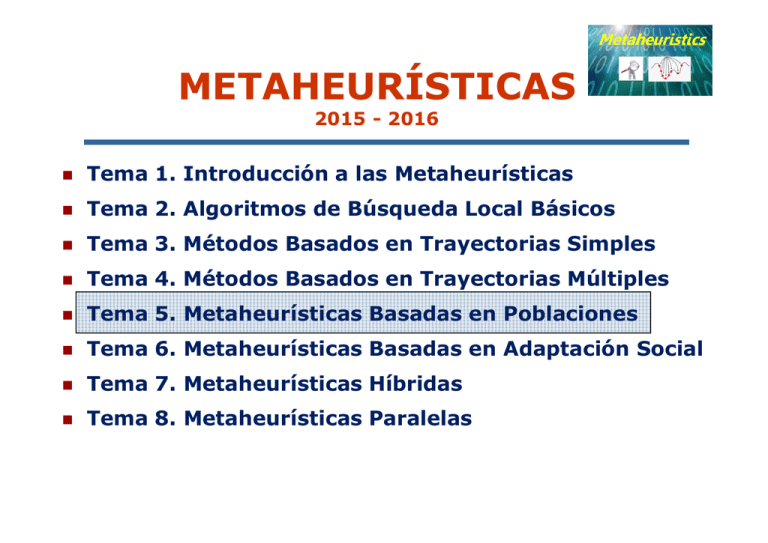
METAHEURÍSTICAS
2015 - 2016
Tema 1. Introducción a las Metaheurísticas
Tema 2. Algoritmos de Búsqueda Local Básicos
Tema 3. Métodos Basados en Trayectorias Simples
Tema 4. Métodos Basados en Trayectorias Múltiples
Tema 5. Metaheurísticas Basadas en Poblaciones
Tema 6. Metaheurísticas Basadas en Adaptación Social
Tema 7. Metaheurísticas Híbridas
Tema 8. Metaheurísticas Paralelas
METAHEURÍSTICAS
TEMA 5. METAHEURÍSTICAS BASADAS
EN POBLACIONES
Parte III:
1. COMPETICIÓN CEC2014 (SHADE y extensiones)
2. NUEVOS MODELOS BIOINSPIRADOS PARA
OPTIMIZACIÓN DE PARÁMETROS
2
METAHEURÍSTICAS
TEMA 5. METAHEURÍSTICAS BASADAS
EN POBLACIONES
Parte II:
1. COMPETICIÓN CEC2014 (SHADE y extensiones)
2. NUEVOS MODELOS BIOINSPIRADOS PARA
OPTIMIZACIÓN DE PARÁMETROS
3
Milestone: CEC’2013 Real Parameter
Optimization Session and Benchmark
Winners extend CMAES
Special Session & Competition on
Real-Parameter Single Objective
Optimization at CEC-2013, Cancun,
Mexico 21-23 June 2013.
•J. J. Liang, B-Y. Qu, P. N. Suganthan, Alfredo
G. Hernández-Díaz, "Problem Definitions and
Evaluation Criteria for the CEC 2013 Special
Session and Competition on Real-Parameter
Optimization", Technical Report 201212,
Computational
Intelligence
Laboratory,
Zhengzhou
University,
Zhengzhou
China
and
Technical Report, Nanyang
Technological University, Singapore, January
2013.
Milestone: CEC’2013 Real Parameter
Optimization Session and Benchmark
Winners extend CMAES
Milestone: CEC’2013 Real Parameter
Optimization Session and Benchmark
Winners extend CMAES
http://www.ntu.edu.sg/home/epnsugan/index_fi
les/cec-benchmarking.htm
http://www.ntu.edu.sg/home/EPNSugan/index_
files/CEC2013/CEC2013.htm
•Benchmark Results for a Simple Hybrid Algorithm on the CEC 2013 Benchmark Set for Real
parameter Optimization [#1566] . . Tianjun Liao and Thomas Stuetzle Universite Libre de Bruxelles
(ULB), IRIDIA, Belgium (Codes-Results available, as ICMAES-ILS)
•CMA-ES with Restarts for Solving CEC 2013 Benchmark Problems [#1318] . Ilya Loshchilov Ecole
Polytechnique Federale de Lausanne, Laboratory of Intelligent Systems, Switzerland (CodesResults available, as NBIPOPaCMA)
•Dynamically updated Region Based Memetic Algorithm for the 2013 CEC Special Session and
Competition on Real Parameter Single Objective Optimization [#1617] . . Benjamin Lacroix, Daniel
Molina and Francisco Herrera Universidad de Granada, Spain; Universidad de Cadiz,
Spain (Codes-Results available, as DRMA-LSch-CMA)
SHADE 1.0 was a 4th ranked evolutionary algorithm out of the 21 entries at the
CEC2013 Competition on Real-Parameter Single Objective Optimization.
Milestone: CEC’2014 Real Parameter
Optimization Session and Benchmark
Differential Evolution winner
http://www.ntu.edu.sg/home/EPNSugan/index_files/CEC2014/CEC2014.htm
There are again two MAs among the three winner algorithms:
CEC2014
J. J. Liang, B-Y. Qu, P. N.
Suganthan, Problem
Definitions and Evaluation
Criteria for the CEC 2014
Special Session and
Competition on Single
Objective Real-Parameter
Numerical Optimization,
Technical Report 201311,
Computational Intelligence
Laboratory, Zhengzhou
University, Zhengzhou China
and Technical Report,
Nanyang Technological
University, Singapore,
December 2013.
L-SHADE [1], an extension of SHADE (SHADE got the fourth place
in CEC’2013)
GaAPADE [2], a hybridization of an GA, an DE and an Evolutionary
Strategy;
MVMO [3]
[1] R. Tanabe, A. Fukunaga. Improving the Search Performance of SHADE Using
Linear Population Size Reduction. In IEEE Congress on Evolutionary Computation,
(2014), 1658-1665.
[2] S. Elsayed, S. Ruhul, D. Essam and N. Hamza. Testing United Multi-Operator
Evolutionary Algorithms on the CEC2014 Real-Parameter Numerical Optimization. In
IEEE Congress on Evolutionary Computation, (2014), 1650-1657.
[3] I. Erlich, J.L. Rueda, S. Wildenhues. Evaluating the Mean-Variance Mapping
Optimization on the IEEE-CEC 2014 Test Suite. In IEEE Congress on Evolutionary
Computation, (2014), 1625-1632.
Milestone: CEC’2014 Real Parameter
Optimization Session and Benchmark
Differential Evolution winner
http://www.ntu.edu.sg/home/EPNSugan/index_files/CEC2014/CEC2014.htm
Milestone: CEC’2014 Real Parameter
Optimization Session and Benchmark
Differential Evolution winner
Milestone: CEC’2014 Real Parameter
Optimization Session and Benchmark
Differential Evolution winner - Código
https://sites.google.com/site/tanaberyoji/home
TRABAJO
https://sites.google.com/site/tanaberyoji/home/Tanabe-FukunagaImproving%20the%20Search%20Performance%20of%20SHADE%20Using%2
0Linear%20Population%20Size%20Reduction-CEC14.pdf?attredirects=0&d=1
TRANSPARENCIAS
https://sites.google.com/site/tanaberyoji/home/lshade-cec14slide.pdf?attredirects=0&d=1
1.
EVOLUCIÓN DIFERENCIAL
Es un modelo evolutivo que enfatiza la mutación, utiliza un
operador de cruce/recombinación a posteriori de la mutación.
Fué propuesto para optimización con parámetros reales.
Fue propuesta of R. Storm(Univ. Berkeley), 1997
R. Storn, Differential Evolution, A simple and efficiente heuristic
strategy for global optimization over continuous spaces. Journal
of Global Optimization, 11 (1997) 341-359.
Kenneth V. Price, Rainer M. Storn, and Jouni A. Lampinen
Differential Evolution: A Practical Approach to Global
Optimization (Natural Computing Series)
Springer-Verlag, 2005.
11
1.
•
EVOLUCIÓN DIFERENCIAL
Inicialización:
Una población Px,0 de Np vectores de parámetros D-dimensionales
xi,0=[x1,i,0, …, xD,i,0], i=1,…,Np se genera aleatoriamente dentro de unos límites
inferiores y superiores previos bL=[b1,L, …, bD,L] y bU=[b1,U, …, bD,U].
Ejemplo: el valor inicial (en la generación g=0) del j-ésimo parámetro del i-ésimo
vector se genera por: xj,i,0=randj[0, 1]·(bj,U-bj,L) + bj,L, j=1, …, D, i=1, …, Np.
•
Generación de un vector de prueba:
En la generación g-ésima, una población Pu,g consistente de Np vectores Ddimensionales vi,g=[v1,i,g, …, vD,i,g] a través de operadores de mutación y
recombinación aplicados a la población actual Px,g.
Mutación Diferencial: con respecto a cada vector xi,g en la población actual,
llamado vector objetivo, se genera un vector mutado vi,g añadiendo un vector
diferencia, escalado y aleatoriamente muestreado, a un vector base
aleatoriamente seleccionado de la población actual.
12
1.
EVOLUCIÓN DIFERENCIAL
Imagen de la Evolución Diferencial clásica
13
1.
EVOLUCIÓN DIFERENCIAL
Ejemplo: en la generación g-ésima, el i-ésimo vector mutado vi,g con respecto al
i-ésimo vector objetivo xi,g en la población actual se genera mediante
Vi,g = xr0,g + F · (xr1,g – xr2,g), i ≠ r0 ≠ r1 ≠ r2.
El factor de escalado de la mutación F Є [0,1]
14
1.
EVOLUCIÓN DIFERENCIAL
Ejemplo: en la generación g-ésima, el i-ésimo vector mutado vi,g con respecto al
i-ésimo vector objetivo xi,g en la población actual se genera mediante
Vi,g = xr0,g + F · (xr1,g – xr2,g), i ≠ r0 ≠ r1 ≠ r2.
El factor de escalado de la mutación F Є [0,1]
15
1.
EVOLUCIÓN DIFERENCIAL
Ejemplo: en la generación g-ésima, el i-ésimo vector mutado vi,g con respecto al
i-ésimo vector objetivo xi,g en la población actual se genera mediante
Vi,g = xr0,g + F · (xr1,g – xr2,g), i ≠ r0 ≠ r1 ≠ r2.
El factor de escalado de la mutación F Є [0,1]
mutación
16
1.
•
EVOLUCIÓN DIFERENCIAL
Recombinación Discreta:
Con respecto a cada vector objetivo xi,g en la población actual, un nuevo vector
ui,g se genera cruzando el vector objetivo xi,g con el correspondiente vector
mutado vi,g bajo un ratio predefinido de cruce Cr Є [0, 1].
Ejemplo: en la generación g-ésima, el i-ésimo vector ui,g con respecto al i-ésimo
vector objetivo xi,g en la población actual se genera mediante:
•
Reemplazamiento:
Si el vector ui,g tiene mejor valor de la función objetivo que su correspondiente
vector objetivo xi,g , sustituye el vector objetivo en la generación (g+1); si esto no
ocurre, el vector objetivo permanece en la generación (g+1).
17
1.
EVOLUCIÓN DIFERENCIAL
cruce
18
1.
EVOLUCIÓN DIFERENCIAL
sustitución
19
1.
EVOLUCIÓN DIFERENCIAL
Procedimiento Básico – Evolución Diferencial
Procedure DE{
t = 0;
Initialize Pop(t);
/* of |Pop(t)| Individuals */
Evaluate Pop(t);
While (Not Done)
{for i = 1 to |Pop(t)| do
{parent1, parent2, parent3} = Select_3_Parents(Pop(t));
thisGene = random_int(|Pop(t)|;
for k = 1 to n do /* n genes per Individual */
if (random < p) *P is crossover constant in [0,1]*
Offspringik = parent1ik + γ(parent2ik – parent3ik);
else
Offspringik = Individualik in Pop(t);
end /* for k */
Evaluate(Offspringi);
end /* for i */
Pop(t+1) = {j | Offspringj is_better_than Individualj}
{k | Individualk is_better_than Offspringk};
t = t + 1;}
CÓDIGO: http://www.icsi.berkeley.edu/~storn/code.html
20
2.
VARIANTES DE LA
EVOLUCIÓN DIFERENCIAL
• Mutación diferencial:
• Vector de una diferencia: F · (xr1 – xr2)
• Vector de dos diferencias: F · (xr1 – xr2) + F · (xr3 – xr4)
• Factor de escalado de mutación F
• Rol crucial: balance exploración y explotación.
21
2.
VARIANTES DE LA
EVOLUCIÓN DIFERENCIAL
• Recombinación
• Recombinación discreta (cruce) (variante rotacional)
• Un punto y multipunto
• Exponencial
• Binomial (uniforme)
• Recombinación aritmética
• Recombinación lineal (invariante rotacional)
• Recombinación intermedia (variante rotacional)
• Recombinación intermedia extendida (variante rotacional)
22
2.
VARIANTES DE LA
EVOLUCIÓN DIFERENCIAL
Ratio de cruce CR Є [0, 1]
Descomponible (CR pequeño) y funciones no descomponibles (CR grande)
Guía práctica:
Np Є [5D, 10D]; elección inicial de F = 0.5 y CR = 0.1 / 0.9;
Incrementar Np y / o F si encontramos convergencia prematura.
23
3.
ALGUNOS TRABAJOS EN
EVOLUCIÓN DIFERENCIAL
R. Storn and K. V. Price, “Differential evolution-A simple
and Efficient Heuristic for Global Optimization over
Continuous Spaces,” Journal of Global Optimization,
11:341-359,1997.
K. V. Price, R. Storn, J. Lampinen, Differential Evolution A Practical Approach to Global Optimization, Springer,
Berlin, 2005.
U. K. Chakraborty, Advances in Differential Evolution,
Heidelberg,
Germany: Springer-Verlag, 2008.
24
3.
ALGUNOS TRABAJOS CLÁSICOS EN
EVOLUCIÓN DIFERENCIAL
SaDE: Self adaptive Differential Evolution
• Para alcanzar los mejores resultados en un problema, es frecuente usar una
búsqueda prueba-error para dar valor a esos parámetros: CR, F, NP. Se
requiere mucho tiempo.
• SaDE se propone para ajustar tanto soluciones como valores de parámetros.
• Se consideran varias estrategias y se elige aquella que funcionó mejor en
generaciones previas.
• De alta convergencia: DE/rand-to-best/2/bin.
• De lenta convergencia: DE/rand/1/bin.
• De dos diferencias, para ofrecer mejores perturbaciones: DE/rand/2/bin
• Estrategia de rotación invariante: DE/current-to-rand/1.
• La probabilidad de elección de cada estrategia se adapta mediante una
memoria de fallos y aciertos.
• SaDE adapta los parámetros CR y F. Inicialización: F~N(0.5,0.3), CR~N(0.5,0.1)
A.K. Qin, V.L. Huang, P.N. Suganthan. Differential Evolution Algorithm with strategy Adaptation for
Global Numerical Optimization. IEEE Transactions on Evolutionary Computation, 13:2 (2009) 398-417.
25
3.
ALGUNOS TRABAJOS CLÁSICOS EN
EVOLUCIÓN DIFERENCIAL
JADE: Adaptive Differential Evolution
• Utiliza un esquema DE/current-to-pbest y autoadapta los parámetros F y CR.
• Donde se escoge aleatoriamente uno de los 100p% mejores.
• xr2 puede escogerse entre la población y un archivo opcional, que mantiene
soluciones no seleccionadas aleatoriamente en generaciones anteriores.
• Autoadaptación de parámetros similar a SaDE.
J. Zhang, A.C. Sanderson. JADE: Adaptive Differential Evolution with Optional External Archive.
IEEE Transactions on Evolutionary Computation, 13:5 (2009) 945-958.
26
Shade y L-Shade
https://sites.google.com/site/tanaberyoji/home
Shade y L-Shade
Shade y L-Shade
Shade y L-Shade
Shade y L-Shade
Shade y L-Shade
Shade y L-Shade
Shade y L-Shade
Shade y L-Shade
Shade y L-Shade
Shade y L-Shade
Shade y L-Shade
Shade y L-Shade
Shade y L-Shade
Shade y L-Shade
Shade y L-Shade
Shade y L-Shade
Shade y L-Shade
Shade y L-Shade
Shade y L-Shade
Shade y L-Shade
Shade y L-Shade
Shade y L-Shade
Shade y L-Shade
Shade y L-Shade
Shade y L-Shade
Shade y L-Shade
Shade y L-Shade
Shade y L-Shade
Shade y L-Shade
Shade y L-Shade
Shade y L-Shade
Shade y L-Shade
CEC2014
Shade y L-Shade
CEC’2015 Real Parameter
http://www.ntu.edu.sg/home/EPNSugan/index_files/CEC2015/CEC2015.htm
A self-optimization approach for L-SHADE
incorporated with eigenvector-based crossover
and successful-parent-selecting framework on
CEC 2015 benchmark set
Shu-Mei Guo ; Comput. Sci. & Inf. Eng., Nat. Cheng-Kung
Univ., Tainan, Taiwan ; Jason Sheng-Hong Tsai ; ChinChang Yang ; Pang-Han Hsu
Shade y L-Shade
CEC’2015 Real Parameter
SPS-L-SHADE-EIG
A self-optimization approach for L-SHADE incorporated with eigenvector-based
crossover and successful-parent-selecting framework on CEC 2015 benchmark set
Shu-Mei Guo ; Comput. Sci. & Inf. Eng., Nat. Cheng-Kung Univ., Tainan, Taiwan ; Jason ShengHong Tsai ; Chin-Chang Yang ; Pang-Han Hsu
2015 IEEE Congress on Evolutionary Computation (CEC)
A self-optimization approach and a new success-history based adaptive differential evolution
with linear population size reduction (L-SHADE) which is incorporated with an eigenvectorbased (EIG) crossover and a successful-parent-selecting (SPS) framework are proposed in this
paper. The EIG crossover is a rotationally invariant operator which provides superior
performance on numerical optimization problems with highly correlated variables. The SPS
framework provides an alternative of the selection of parents to prevent the situation of
stagnation. The proposed SPS-L-SHADE-EIG combines the L-SHADE with the EIG and SPS
frameworks. To further improve the performance, the parameters of SPS-L-SHADE-EIG are selfoptimized in terms of each function under IEEE Congress on Evolutionary Computation (CEC)
benchmark set in 2015. The stochastic population search causes the performance of SPS-LSHADE-EIG noisy, and therefore we deal with the noise by re-evaluating the parameters if the
parameters are not updated for more than an unacceptable amount of times. The experiment
evaluates the performance of the self-optimized SPS-L-SHADE-EIG in CEC 2015 real-parameter
single objective optimization competition.
SPS-L-SHADE-EIG
Enhancing Differential Evolution Utilizing Eigenvector-Based Crossover Operator
Shu-Mei Guo ; Chin-Chang Yang
IEEE TEC, 19:1, 2015, 2015, Page(s):31 - 49
Improving Differential Evolution With a Successful-Parent-Selecting Framework
Shu-Mei Guo ; Chin-Chang Yang ; Pang-Han Hsu ; Jason S. -H. Tsai
IEEE TEC, 19:5, 2015, 2015,
Page(s):717 - 730
METAHEURÍSTICAS
TEMA 5. METAHEURÍSTICAS BASADAS
EN POBLACIONES
Parte II:
1. COMPETICIÓN CEC2014 (SHADE y extensiones)
2. NUEVOS MODELOS BIOINSPIRADOS PARA
OPTIMIZACIÓN DE PARÁMETROS
ALGUNOS MODELOS – LA SELECCIÓN NO ES
EXHAUSTIVA NI ESTÁ BASADA EN ESTUDIOS
SOBRE SU COMPORTAMIENTO
64
Nuevos modelos bioinspirados para la optimización
de parámetros (SSO, 2016)
Shark smell optimization
O. Avedinia, N. Amdjady, A. Chasemi (2014). A new metaheuristic algorithm based
Shart Smell Optimization. Complexity, 2016, in press.
Movement of Shark Toward Prey
http://onlinelibrary.wiley.com/doi/10.1002/cplx.21
634/abstract
Nuevos modelos bioinspirados para la optimización
de parámetros (Firefly 2009)
Nuevos modelos bioinspirados para la optimización
de parámetros (Firefly 2009)
Nuevos modelos bioinspirados para la optimización
de parámetros (Jaya: Sanskrit word meaning victory, 2016)
Nuevos modelos bioinspirados para la optimización
de parámetros (TLBO, 2011)
Nuevos modelos bioinspirados para la optimización
de parámetros (TLBO, 2011)
Nuevos modelos bioinspirados para la optimización
de parámetros (EBO and BBO, 2014 and 2008)
Nuevos modelos bioinspirados para la optimización
de parámetros (BBO, 2008)
Nuevos modelos bioinspirados para la optimización
de parámetros (Bat, 2010)
Movements of virtual bats
Nuevos modelos bioinspirados para la optimización
de parámetros ( Cuckoo Search, 2009)
Nuevos modelos bioinspirados para la optimización
de parámetros – Otros Modelos
Z.W. Geem, J.H. Kim, G. Loganathan
A new heuristic optimization algorithm: harmony search
Simulation, 76 (2001), pp. 60–68
D. Karaboga, B. Basturk
A powerful and efficient algorithm for numerical function optimization: artificial bee colony (ABC)
algorithm
J. Glob. Opt., 39 (2007), pp. 459–471
R.A. Formato
Central force optimization: a new nature inspired computational framework for multidimensional
search and optimization
Nature Inspired Cooperative Strategies for Optimization (NICSO 2007), Springer (2008), pp. 221–238
E. Rashedi, H. Nezamabadi-Pour, S. Saryazdi
GSA: a gravitational search algorithm
Inf. Sci., 179 (2009), pp. 2232–2248
R. Oftadeh, M.J. Mahjoob, M. Shariatpanahi
A novel meta-heuristic optimization algorithm inspired by group hunting of animals: hunting search
Comput. Math. Appl., 60 (2010), pp. 2087–2098
Nuevos modelos bioinspirados para la optimización
de parámetros – Otros Modelos
A.Y. Lam, V.O. Li
Chemical-reaction-inspired metaheuristic for optimization
IEEE Trans. Evol. Comput., 14 (2010), pp. 381–399
W.-T. Pan
A new fruit fly optimization algorithm: taking the financial distress model as an example
Knowl.-Based Syst., 26 (2012), pp. 69–74
A. Kaveh, M. Khayatazad
A new meta-heuristic method: ray optimization
Comput. Struct., 112–113 (2012), pp. 283–294
A. Kaveh, N. Farhoudi
A new optimization method: Dolphin echolocation
Adv. Eng. Softw., 59 (2013), pp. 53–70
M. Abdechiri, M.R. Meybodi, H. Bahrami
Gases Brownian motion optimization: an algorithm for optimization (GBMO)
Appl. Soft Comput., 13 (2013), pp. 2932–2946
Nuevos modelos bioinspirados para la optimización
de parámetros – Otros Modelos
E. Cuevas, A. Echavarría, M.A. Ramírez-Ortegón
An optimization algorithm inspired by the states of matter that improves the balance between
exploration and exploitation
Appl. Intell., 40 (2014), pp. 256–272
S. Mirjalili, S.M. Mirjalili, A. Lewis
Grey wolf optimizer
Adv. Eng. Softw., 69 (2014), pp. 46–61
M.-Y. Cheng, D. Prayogo
Symbiotic organisms search: a new metaheuristic optimization algorithm
Comput. Struct., 139 (2014), pp. 98–112
N. Moosavian, B. Kasaee Roodsari
Soccer league competition algorithm: a novel meta-heuristic algorithm for optimal design of
water distribution networks
Swarm Evol. Comput., 17 (2014), pp. 14–24
Nuevos modelos bioinspirados para la optimización
de parámetros – Otros Modelos
Nuevos modelos bioinspirados para la optimización
de parámetros - Modelos
Nuevos modelos bioinspirados para la optimización
de parámetros - Modelos
Nuevos modelos bioinspirados para la optimización
de parámetros - Modelos
Nuevos modelos bioinspirados para la optimización
de parámetros - Modelos
Nuevos modelos bioinspirados para la optimización
de parámetros - Modelos
Estudio
comparativo
incluyendo
CMAES
Nuevos modelos bioinspirados para la optimización de parámetros –
Análisis crítico a esta explosión de propuestas
METAHEURÍSTICAS
TEMA 5. METAHEURÍSTICAS BASADAS
EN POBLACIONES
Parte III:
1. COMPETICIÓN CEC2014 (F1 a F20), 10 y 30
dimensión (50 opcional)
http://web.mysites.ntu.edu.sg/epnsugan/PublicSite/Shared
%20Documents/Forms/AllItems.aspx
http://web.mysites.ntu.edu.sg/epnsugan/PublicSite/Shared
%20Documents/Forms/AllItems.aspx?RootFolder=%2fepnsu
gan%2fPublicSite%2fShared%20Documents%2fCEC2014&FolderCTID=&View=%7bDAF31868-97D8-4779AE49-9CEC4DC3F310%7d
85
METAHEURÍSTICAS
2015 - 2016
Tema 1. Introducción a las Metaheurísticas
Tema 2. Algoritmos de Búsqueda Local Básicos
Tema 3. Métodos Basados en Trayectorias Simples
Tema 4. Métodos Basados en Trayectorias Múltiples
Tema 5. Metaheurísticas Basadas en Poblaciones
Tema 6. Metaheurísticas Basadas en Adaptación Social
Tema 7. Metaheurísticas Híbridas
Tema 8. Metaheurísticas Paralelas
86

